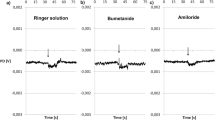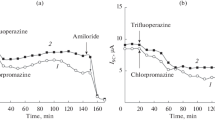Summary
The stimulation of apical Na permeability caused by a number of reagents effective from the outer side of the membrane was investigated by fluctuation analysis. In the epidermis ofR. ridibunda, parachloromercuriphenyl sulfonate (PCMPS) and benzimidazolyl guanidine (BIG) increase the number (N 0) of conducting Na channels by releasing channels from Na self-inhibition. As a consequence, the apparent macroscopic affinity for amiloride is increased. 5-dimethyl amiloride and trinitrobenzene sulfonate (TNBS) also cause reversible stimulation by increasingN 0; here release from self-inhibition is less clear. With each of the four stimulators investigated, the Na channel current remained unaffected or was only marginally increased. In addition to its stimulatory effect, TNBS caused irreversible blockage of Na channels. Apart from their stimulatory effects, BIG and 5-dimethyl amiloride, both of which have a side-chain terminated with an amidino group, are high rate-blocking competitors of amiloride.
Similar content being viewed by others
References
Angelone, L. 1965. Hemolysis of rat erythrocytes byp-hydroxymercuribenzoate and N-ethylmaleimide.Arch. Biochem. Biophys. 112:288–293
Arrotti, J.J., Garvin, J.E. 1972. Reaction of human serum albumin and human eruthrocytes with titrated 2,4,6-trinitrobenzenesulfonic acid and tritiated picryl chloride.Biochim. Biophys. Acta 255:79–90
Balaban, R.S., Mandel, L.J., Benos, D.J. 1979. On the crossreactivity of amiloride and 2,4,6-triaminopyrimidine (TAP) for the cellular entry and tight junctional cation permeation pathways in epithelia.J. Membrane Biol..49:363–390
Barnes, T.C. 1939. The electrical potential of frog skin stained with fluorescent dyes.J. Cell. Comp. Physiol. 14:83–94
Benos, D.J., Mandel, L.J., Simon, S.A. 1980. Effects of chemical group specific reagents on sodium entry and the amiloride binding site in frog skin: Evidence for separate sites.J. Membrane Biol. 56:149–158
Benos, D.J., Simon, S.A., Mandel, L.J., Cala, P.M. 1976. Effect of amiloride and some of its analogues on cation transport in isolated frog skin and thin lipid membranes.J. Gen. Physiol. 68:43–63
Bevevino, L.H., Lacaz-Vieira, F. 1982. Control of sodium permeability of the outer barrier in toad skin.J. Membrane Biol. 66:97–107
Chase, H.S., Jr., Al-Awqati, Q. 1981. Regulation of the sodium permeability of the luminal border of toad bladder by intracellular sodium and calcium.J. Gen. Physiol. 77:693–712
Cuthbert, A.W. 1976. Importance of guanidinium groups for blocking sodium channels in epithelia.Mol. Pharmacol. 12:945–957
Cuthbert, A.W., Shum, W.K. 1974. Binding of amiloride to sodium channels in frog skin.Mol. Pharmacol. 10:880–891
Cuthbert, A.W., Shum, W.K. 1976. Induction of transporting sites in a sodium transporting epithelium.J. Physiol. (London) 260:223–235
Cuthbert, A.W., Shum, W.K. 1978. Interdependence of the two borders in a sodium transporting epithelium. Possible regulation by the transport pool.J. Membrane Biol. Special Issue:221–245
Cuthbert, A.W., Wong, P.Y.D. 1972. The role of calcium ions in the interaction of amiloride with membrane receptors.Mol. Pharmacol. 8:222–229
DeSousa, R.C., Grosso, A. 1973. Effects of diphenylhydantoin on transport processes in frog skin (Rana ridibunda).Experientia 29:1097–1098
DeSousa, R.C., Grosso, A. 1978. Vasopressin-like effects of a hallucinogenic drug-harmaline — on sodium and water transport.J. Membrane Biol. 40:77–94
Dick, H.J. 1977. Der Einfluss von Sulfhydrylreagenzien auf den transepithelialen Na-Transport der isolierten Froschhaut. M. D. Thesis, Universität des Saarlandes, Medical Faculty 665 Homburg, F.R.G.
Dick, H.J., Lindemann, B. 1975. Saturation of Na-current into frog skin epithelium abolished by PCMPS.Pfluegers Arch. 355:R72
Fallenstein, G. 1980. Die Wirkung von Glutardialdehyd auf das apikale Na-Transportsystem im Epithel der Froschhaut. M.D. Thesis, Universität des Saarlandes, Medical Faculty 6650 Homburg, F.R.G.
Fallenstein, G., Lindemann, B. 1979. Passive Na-uptake of frog skin: Alterations by fixation with glutardialdehyde.Pfluegers Arch. 379:R17
Freedman, R.B., Radda, G.K. 1968. The reaction of 2,4,6-trinitrobenzenesulfonic acid with amino acids, peptides and proteins.Biochem. J. 108:383–391
Friedman, M. 1973. The Chemistry and Biochemistry of the Sulfhydryl Group in Amino Acids, Peptides and Proteins. Pergamon Press, New York
Fuchs, W., Hviid Larsen, E., Lindemann, B. 1977. Current voltage curve of sodium channels and concentration dependence of sodium permeability in frog skin.J. Physiol. (London) 267:137–166
Fülgraff, G., Gulden, W.D., Rudroff, W.D. 1973. Effect of furosemide on sodium transport in frog skin.Arch. Pharmacol. 280:23–38
Garcia-Romeau, F. 1974. Stimulation of sodium transport in frog skin by 2-imidazolines (guanidinebenzimidazole and phentolamine).Life Sci. 15:539–542
Grinstein, S., Candia, O., Erlij, D. 1978. Nonhormonal mechanisms for the regulation of transepithelial sodium transport: The roles of surface potential and cell calcium.J. Membrane Biol. Special Issue:261–280
Harms, V., Fanestil, D.D. 1977. Functions of apical membrane of toad urinary bladder: Effects of membrane impermeant reagents.Am. J. Physiol. 233:F607-F614
Janaček, K. 1962. The effect of low concentrations of thiolgroup blocking agents on the outer membrane of frog skin.Biochim. Biophys. Acta 56:42–48
Johnston, K.H., Hoshiko, T. 1971. Novobiocin stimulation of frog skin current and some metabolic consequences.Am. J. Physiol. 220:792–798
Kirschner, L.B. 1955. The effect of atropine and the curares on the active transport of sodium by the skin ofRana esculenta.J. Cell. Comp. Physiol. 45:89–102
Knauf, P.A., Rothstein, A. 1971. Chemical modification of membranes. I: Effect of sulfhydryl and amino reactive reagents on anion and cation permeability of the human red blood cell.J. Gen. Physiol. 58:190–210
Kramer, H.J. 1976. Effects of bumetanide on sodium transport of the isolated frog skin and on renal Na−K-ATPase.Pharmacology 14:481–489
Li, J.H.-Y., DeSousa, R.C. 1979. Inhibitory and stimulatory effects of amiloride analogues on sodium transport in frog skin.J. Membrane Biol. 46:155–169
Li, J.H.-Y., Lindemann, B. 1980. The mechanism of chemical stimulation of amiloride sensitive Na channels.Pfluegers Arch. 384:R7
Li, J.H.-Y., Lindemann, B. 1981. Blockage of epithelial Na channels by organic cations: The relationship of microscopic and macroscopic inhibition constants.Pfluegers Arch. 391:R25
Li, J.H.-Y., Palmer, L.G., Edelman, I.S., Lindemann, B. 1982. The role of Na channel density in the natriferic response of the toad urinary bladder to an antidiuretic hormone.J. Membrane Biol. 64:77–89
Lindemann, B. 1977. A modifier-site model for passive Na transport into frog skin epithelium.In: Intestinal, Permeation. M. Kramer and F. Lauterbach, editors. pp. 217–228. Excerpta Medica, Amsterdam
Lindemann, B. 1978. Steady state kinetics of a floating receptor model for the inhibition of sodium uptake by sodium in frog skin.In: Renal Function. G.H. Giebisch and E.F. Purcell, editors. pp. 110–131. Waverly Press, Baltimore
Lindemann, B., DeFelice, L.J. 1981. On the use of general network functions in the evaluation of noise spectra obtained from epithelia.In: Ion Transport by Epithelia. S.G. Schultz, editor. pp. 1–13. Raven Press, New York
Lindemann, B., Van Driessche, W. 1978. The mechanism of Na uptake through Na-selective channels in the epithelium of frog skin.In: Membrane Transport Processes. J.F. Hoffman, editor. Vol. 1, pp. 155–178. Raven Press, New York
Lindemann, B., Voûte, C. 1976. Structure and function of the epidermis.In: Frog Neurobiology. R. Llinás and W. Precht, editors. pp. 169–210. Springer Verlag, Berlin-Heidelberg-New York
Means, G.E., Feeney, R.E. 1971. Chemical Modification of Proteins. Holden-Day, San Francisco
Skou, J., Hilberg, C. 1965. The effect of sulfhydryl blocking reagents and of urea on the (Na+K)-activated enzyme system.Biochim. Biophys. Acta 110:359–369
Skou, J.C., Zerahn, K. 1959. Investigations on the effect of some local anaesthetics and other amines on the active transport of sodium through the isolated short-circuited frog skin.Biochim. Biophys. Acta 35:324–333
Spooner, P.M., Edelman, I.S. 1976. Stimulation of Na+ transport across the toad urinary bladder byp-chloromercuribenzene sulfonate.Biochim. Biophys. Acta 455:272–276
Taylor, A., Windhager, E.E. 1979. Possible role of cytosolic calcium and Na−Ca exchange in regulation of transepithelial sodium transport.Am. J. Physiol. 236:F505-F512
Thurman, C.L., Higgins, J.T. 1982. Amiloride stimulation of sodium transport in the presence of calcium and a divalent cation chelator.Biochim. Biophys. Acta 689:561–566
Van Driessche, W., Lindemann, B. 1978. Low-noise amplification of voltage and current fluctuations arising in epithelia.Rev. Sci. Instrum. 49:52–55
Zeiske, W. 1975. The influence of 2,4,6-triaminopyrimidine on Na transport in frog skin.Pfluegers Arch. 359:R127
Zeiske, W., Lindemann, B. 1974. Chemical stimulation of Na current through the outer surface of frog skin epithelium.Biochim. Biophys. Acta 352:323–326
Author information
Authors and Affiliations
Rights and permissions
About this article
Cite this article
Li, J.H.Y., Lindemann, B. Chemical stimulation of Na transport through amiloride-blockable channels of frog skin epithelium. J. Membrain Biol. 75, 179–192 (1983). https://doi.org/10.1007/BF01871949
Received:
Issue Date:
DOI: https://doi.org/10.1007/BF01871949




